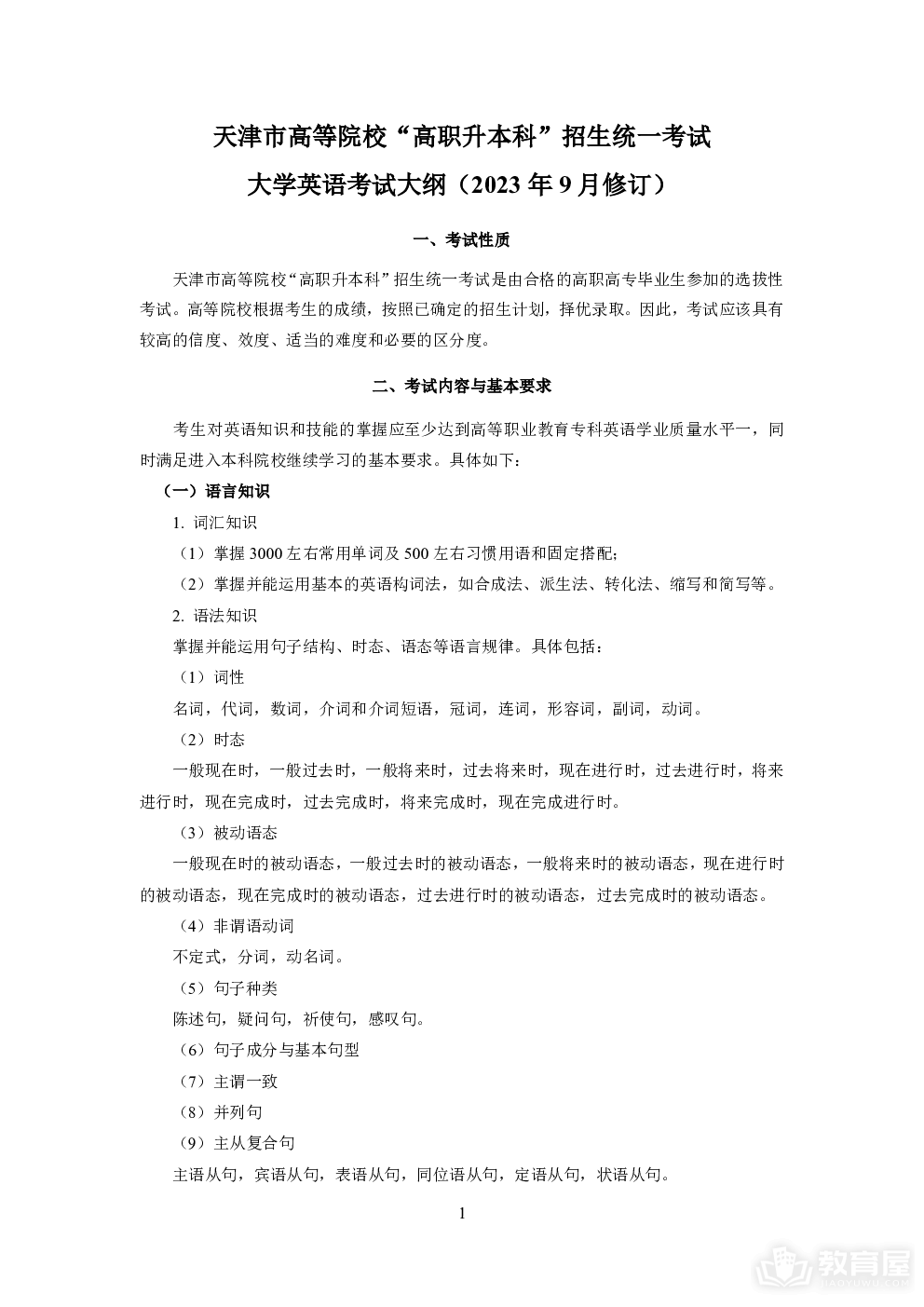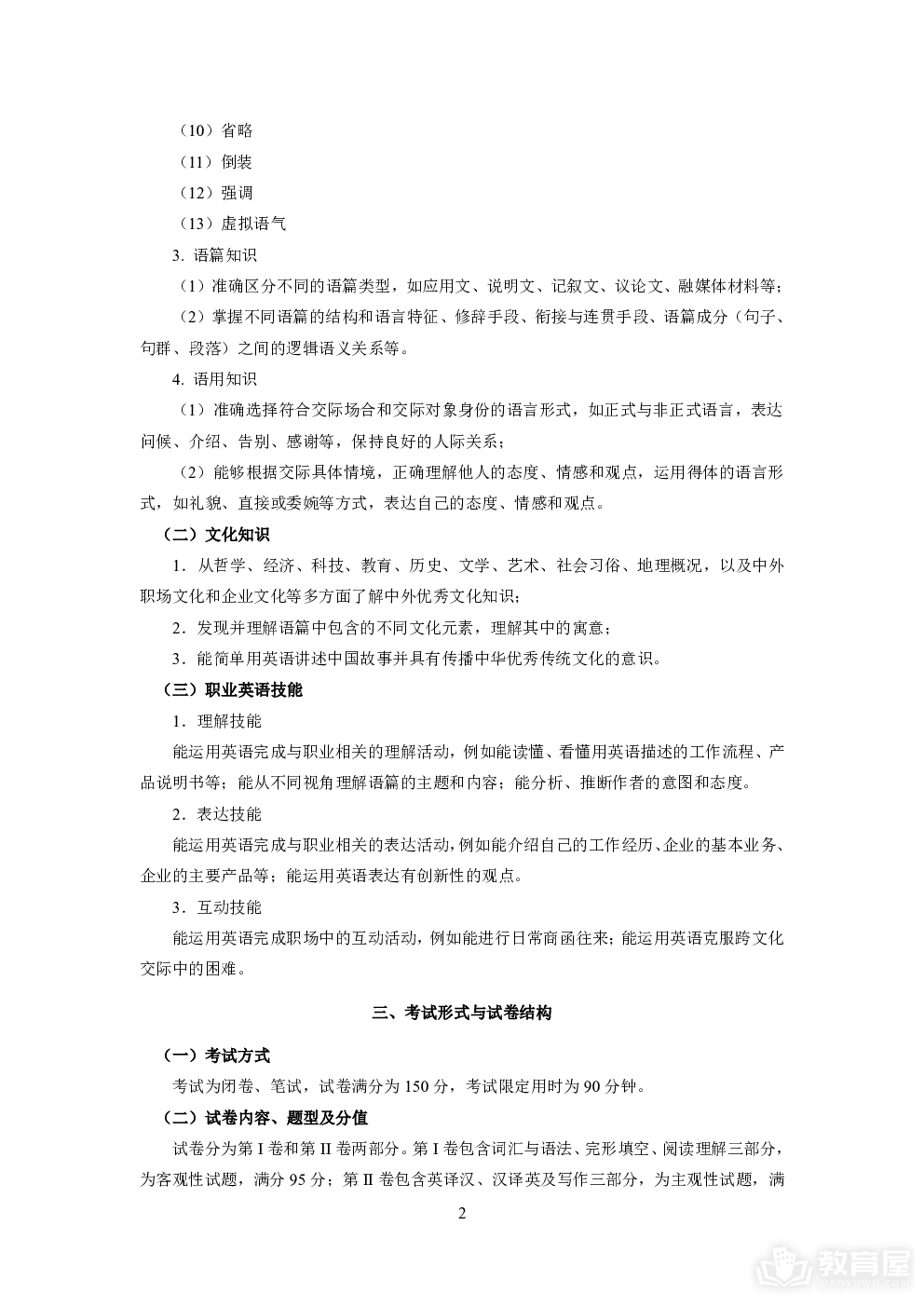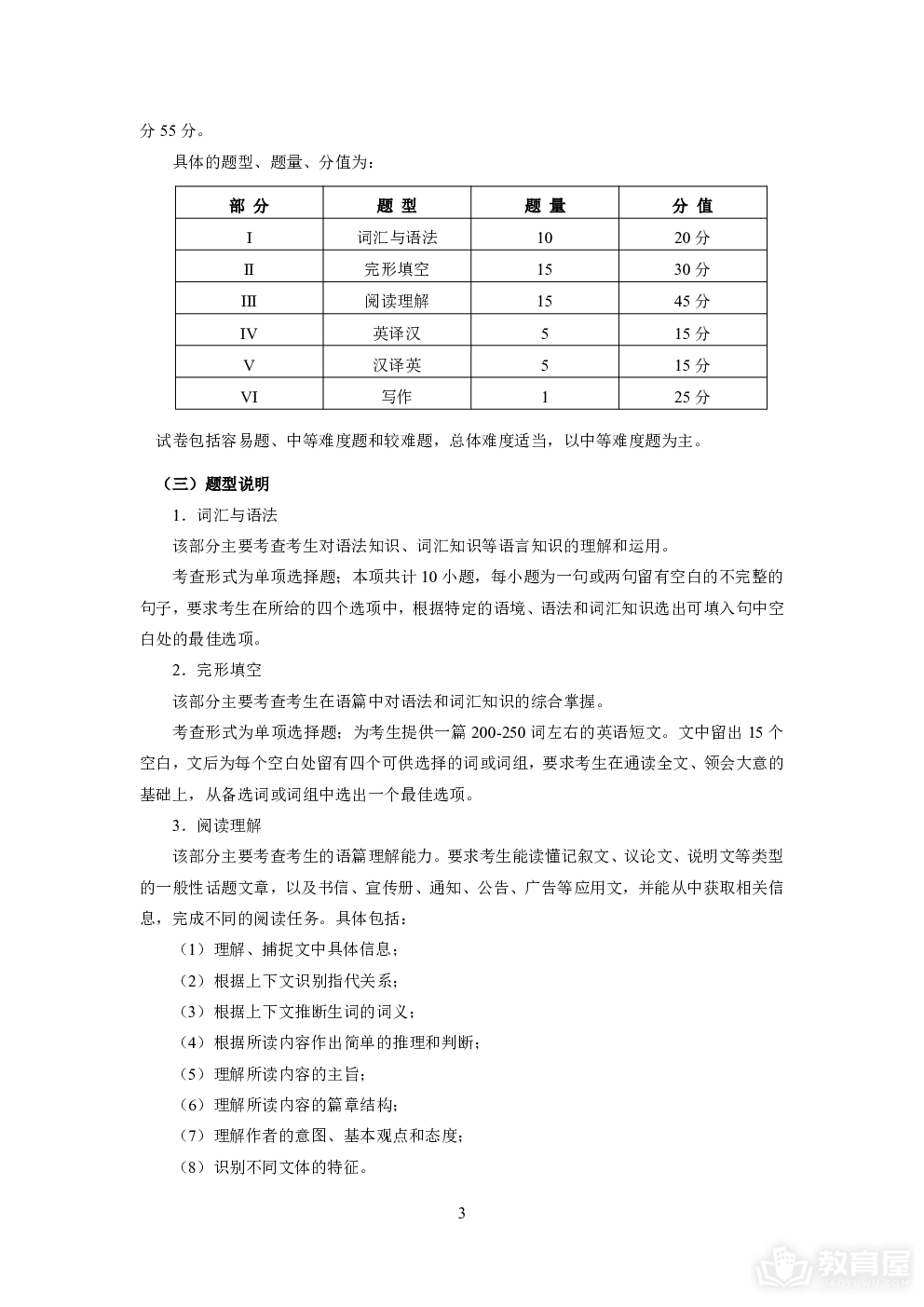天津市高职升本科英语考试大纲(2023年9月修订).pdf



1 天津市高等院校 “ 高职升本科 ” 招生统一考试 大学英语考试大纲 ( 2023 年 9 月修订 ) 一 、 考试性质 天津市高等院校 “ 高职升本科 ”招生统一考试是由合格的高职高专毕业生参加的选拔性 考试 。高等院校根据考生的成绩 ,按照已确定的招生计划 ,择优录取 。因此 ,考试应该具有 较高的信度 、 效度 、 适当的难度和必要的区分度 。 二 、 考试内容与基本要求 考生对英语知识和技能的掌握应 至少 达到 高等职业教育专科英语学业质量水平一 , 同 时满足进入本科院校继续学习的基本要求 。 具体如下 : ( 一 ) 语言知识 1. 词汇知识 ( 1) 掌握 3000 左右常用单词及 500 左右习惯用语和固定搭配 ; ( 2) 掌握并能运用基本的 英语构词法 , 如合成法 、 派生法 、 转化法 、 缩写和简写等 。 2.语法知识 掌握并能运用 句子结构 、 时态 、 语态等语言规律 。 具体包括 : ( 1) 词性 名词 , 代词 , 数词 , 介词和介词短语 , 冠词 , 连词 , 形容词 , 副词 , 动词 。 ( 2) 时态 一般现在时 ,一般过去时 ,一般将来时 ,过去将来时 ,现在进行时 ,过去进行时 ,将来 进行时 , 现在完成时 , 过去完成时 , 将来完成时 , 现在完成进行时 。 ( 3) 被动语态 一般现在时的被动语态 ,一般过去时的被动语态 ,一般将来时的被动语态 ,现在进行时 的被动语态 , 现在完成时的被动语态 , 过去进行时的被动语态 , 过去完成时的被动语态 。 ( 4) 非谓语动词 不定式 , 分词 , 动名词 。 ( 5) 句子种类 陈述句 , 疑问句 , 祈使句 , 感叹句 。 ( 6) 句子成分与基本句型 ( 7) 主谓一致 ( 8) 并列句 ( 9) 主从复合句 主语从句 , 宾语从句 , 表语从句 , 同位语从句 , 定语从句 , 状语从句 。
2 ( 10 ) 省略 ( 11) 倒装 ( 12) 强调 ( 13) 虚拟语气 3.语篇知识 ( 1)准确区分不同的语篇类型 ,如应用文 、说明文 、记叙文 、议论文 、融媒体材料等 ; ( 2)掌握不同语篇的结构和语言特征 、修辞手段 、衔接与连贯手段 、语篇成分 ( 句子 、 句群 、 段落 ) 之间的逻辑语义关系等 。 4.语用知识 ( 1) 准确选择符合交际场合和交际对象身份的语言形式 , 如正式与非正式语言 , 表达 问候 、 介绍 、 告别 、 感谢等 , 保持良好的人际关系 ; ( 2) 能够根据交际具体情境 , 正确理解他人的态度 、 情感和观点 , 运用得体的语言形 式 , 如礼貌 、 直接或委婉等方式 , 表达自己的态度 、 情感和观点 。 ( 二 ) 文化 知识 1. 从哲学 、 经济 、 科技 、 教育 、 历史 、 文学 、 艺术 、 社会习俗 、 地理概况 , 以及中外 职场文化和企业文化等多方面了解中外优秀文化知识 ; 2. 发现并理解语篇中包含的不同文化元素 , 理解其中的寓意 ; 3. 能简单用英语讲述中国故事并具有传播中华优秀传统文化的意识 。 ( 三 ) 职业英语技能 1. 理解技能 能运用英语完成与职业相关的理解活动 ,例如能读懂 、看懂用英语描述的工作流程 、产 品说明书等 ; 能从不同视角理解语篇的主题和内容 ; 能分析 、 推断作者的意图和态度 。 2. 表达技能 能运用英语完成与职业相关的表达活动 ,例如能介绍自己的工作经历 、企业的基本业务 、 企业的主要产品等 ; 能运用英语表达有创新性的观点 。 3. 互动技能 能运用英语完成职场中的互动活动 ,例如能进行日常商函往来 ;能运用英语克服跨文化 交际中的困难 。 三 、 考试形式与试卷结构 ( 一 ) 考试方式 考试为闭卷 、 笔试 , 试卷满分为 150 分 , 考试限定用时为 90 分钟 。 ( 二 ) 试卷内容 、 题型及分值 试卷分为第 I卷和第 II卷两部分 。第 I卷包含词汇与语法 、完形填空 、阅读理解三部分 , 为客观性试题 , 满分 95 分 ; 第 II卷包含英译汉 、 汉译英及写作三部分 , 为主观性试题 , 满
3 分 55 分 。 具体的题型 、 题量 、 分值为 : 部 分 题 型 题 量 分 值 I 词汇与语法 10 20 分 II 完形填空 15 30 分 III 阅读理解 15 45 分 IV 英译汉 5 15 分 V 汉译英 5 15 分 VI 写作 1 25 分 试卷包括容易题 、 中等难度题和较难题 , 总体难度适当 , 以中等难度题为主 。 ( 三 ) 题型说明 1. 词汇与语法 该部分主要考查考生对语法知识 、 词汇知识等语言知识的理解和运用 。 考查形式为单项选择题 ; 本项共计 10小题 , 每小题为一句或两句留有空白的不完整的 句子 ,要求考生在所给的四个选项中 ,根据特定的语境 、语法和词汇知识选出可填入句中空 白处的最佳选项 。 2. 完形填空 该部分主要考查考生在语篇中对语法和词汇知识的综合掌握 。 考查形式为单项选择题 ; 为考生提供一篇 200-250 词左右的英语短文 。 文中留出 15 个 空白 ,文后为每个空白处留有四个可供选择的词或词组 ,要求考生在通读全文 、领会大意的 基础上 , 从备选词或词组中选出一个最佳选项 。 3. 阅读理解 该部分主要考查考生的语篇理解能力 。要求考生 能读懂 记叙文 、议论文 、说明文等类型 的 一般性话题 文章 ,以及 书信 、宣传册 、通知 、公告 、广告等 应用文 ,并能从中获取相关信 息 , 完成不同的阅读任务 。 具体包括 : ( 1) 理解 、 捕捉文中具体信息 ; ( 2) 根据上下文识别指代关系 ; ( 3) 根据上下文推断生词的词义 ; ( 4) 根据所读内容作出简单的推理和判断 ; ( 5) 理解所读内容的主旨 ; ( 6) 理解所读内容的篇章结构 ; ( 7) 理解作者的意图 、 基本观点和态度 ; ( 8) 识别不同文体的特征 。
4 考查形式为单项选择题 ; 试卷呈现 A、 B、 C三篇短文 , 每篇长度为 300 词左右 。 其 中 A、 B两篇每篇短文后设 5个问题 , 每个问题有四个备选答案 , 要求考生根据短文内容 , 选 出一个正确答案 。 在 C篇文章中 , 文内留出 5句空白 , 文后为 5个空白提供 7个可供选择 的句子 ,要求考生在通读全文 、领会大意的基础上 ,从 7个备选句中选出 5个符合文章结构 、 语意内容及逻辑的选项 。( 可参照所附题型示例 ) 4. 翻译 该部分主要考查考生语言综合运用能力 ,需要考生 完成 日常及职场相关话题的 中英文互 译任务 , 考查形式分为英译汉和汉译英 。 ( 1) 英译汉 该部分为主观性试题 ;为考生提供一篇 200 词左右的短文 ,要求考生在阅读并理解短文 的基础上 , 将文内 5处画线句子翻译成通顺的汉语 。 ( 2) 汉译英 该部分为主观性试题 ;为考生提供 5个独立的中文句子及部分英文提示 ,要求考生根据 英文表达习惯及相关英文提示词 , 将中文句子翻译成通顺的英语 。 5. 写作 该部分考查考生语言综合运用能力和使用英语进行表达的能力 。 考生需 根据题目要求 完成简单的书面表达任务 ,正确有效地运用所学语言知识 ,清楚 、连贯地传递信息 ,表达思 想 , 做到语句通顺 , 结构完整 , 文体规范 。 考查形式为主观性试题 ; 要求考生按照题目要求写一篇不少于 100 词的英语短文 。 具 体类型包括 : ( 1) 职场常用 应用文 写作 , 如日常商函 、 简历 、 通知 、 日程安排等 ; ( 2) 描述 个人故事 、 时事观点或职场案例 , 并进行评论 ; ( 3) 根据文字提纲或图表提供的信息 撰写 短文或报告 。 四 、 题型示例 Part I.Grammar and Vocabulary (20 points) Directions: There are 15 sentences, each with ablank. Under each sentence, there are four choices marked A, B, C and D. Read the sentences and the choices carefully and then choose the one that best completes the sentence. 1. Jack bought ______ useful book. ______ book isalso very interesting. A. an; The B. a;The C. an; A D. a;A 答案 :B 2. The reason for your failure in the examination is______ you didn ’twork hard enough. A. that B. why C. which D. because 答案 :A 3.The wealth of acountry should also be measured ______ the health and happiness of its people. A. in terms of B. in case of C. in favor of D. in place of
5 答案 :A 4.With out electricity, human life ______ quite different today. A. is B. will be C. would be D. would have been 答案 :C Part II. Cloze Test (30 points) Directions: There are 20 blanks in the following passage. For each blank there are four choices marked A, B, C and D. Read the passage carefully and choose the one that fits right into the passage. Men have traveled ever since they first appeared on the earth. In primitive times they did not travel for pleasure but to 1 new places where their herds could feed, or to find more 2 climates. They traveled on foot. Their journeys were long, tiring, and often 3 .They protected themselves with simple tools such as wooden sticks or stone clubs, and by lighting fires at night and, 4 all, by keeping together. Being intelligent and creative, they soon 5 easier ways of traveling. They 6 on the backs of their domesticated animals; they hollowed out tree 7 and, by using bits of wood as paddles, were able to travel across water. Later they traveled, not 8 necessity, but from the joy and excitement of seeing and experiencing new things. This isthe main 9 why we travel today. Traveling, of course, has now become ahighly organized business. There are cars and splendid roads, express trains, huge ships and jet planes, all of 10 provide us with comforts and security. This sounds wonderful, 11 there are difficulties. Ifyou want to go 12 ,you need apassport and avisa, tickets, luggage, and many other things. If you lose any of them, your journey may be 13 . Scientists have invented machines that can explore 14 space. Eventually there will be cheap-way excursions to the moon and people will be able to fly from one 15 to another in little arrow-shaped tubes. 1.A. visit B. explore C. see D. use 2.A. humid B. warm C. cold D. favorable 3.A. pleasant B. dangerous C. comfortable D. cheerful 4.A. above B. after C. at D. in 5.A. gave B. discovered C. changed D. improved 6.A. drove B. moved C. ran D. rode 7.A. branches B. logs C. trunks D. bushes 8.A. for B. with C. from D. without 9.A. cause B. reason C. goal D. purpose 10 .A. that B. these C. which D. those 11 .A. because B. since C. but D. moreover 12 .A. outside B. abroad C. inside D. home 13 .A. hurt B. injured C. spoiled D. destroyed 14 .A. outer B. out C. extra D. open
6 15 .A. continent B. state C. ship D. planet 答案 : 1. B 2. D 3. B 4.A 5. B 6. D 7. C 8.A 9. B 10. C 11. C 12. B 13. C 14. A 15. D Part III. Reading Comprehension (45 points) Directions: There are following three passages. Each passage is followed by several questions or unfinished statements. For each of them there are four choices marked A, B, Cand D. Choose the one that fits best according to the information given in the passage you have just read. Throughout the world, every night children and their elders are “talking ”online — many of them are talking at the same time. If you have been joining in the chat room conversations ,you might have become one of the millions who write inaspecial, short form of English. It’sfast: itallows you to talk to six people at once. It’sconvenient: you can use three or four words per exchange. Ittakes cleverness, concentration and quick fingers. And it requires very simple language. There ’sneither time nor space for explanations. Why bother to press the keys telling six friends you have to leave for amoment to take care of your little brother when BRB (=be right back) will do? Want to enter aconversation? Just type PMFJI (=pardon me for jumping in). Interested in whom you ’re talking to? Type A/S/L, the common request to know your net pal ’s age, sex and location. You may get 15/M/NY as areply from your pal. Ifsomething makes you laugh, say you ’re OTF (=on the floor), or LOL (=laughing out loud), or join the two into ROTFL (=rolling on the floor laughing). And when it’stime to get back to work or go to bed, you type GTG (=got to go) or TTYL (=talk to you later). People want to write as fast as possible, and they want to get their ideas across as quickly as they can. Capital ( 大写的 )letters in sentences are left in the dust, except when expressing feelings, as ittakes more time to hold down the “shift ”key and use capitals. Punctuation ( 标点 ) isgoing, too. 1.According to paragraph 1, online chatting allows people in the world to ______. A. learn millions of words B. pick out things to buy C. talk at the same time D. find out funny things 2. What does the underlined sentence in paragraph 2mean? A. People have to communicate in afunny way. B. People have to express themselves in aproper way. C. People have to communicate in alogical way. D. People have to express themselves in asimple way. 3.An answer q 19/M/HK r to your A/S/L question means ______. A. a19-year-old boy from Hong Kong B. aboy being online for 19 minutes C. being in Hong Kong for 19 months D. 19 boys from Hong Kong
7 4. Which of the following isaway to save time when chatting online? A. Using less short forms of English. B. Using less capital letters or punctuations. C. Coming up with ideas as quickly as possible. D. Using the “shift ”key when sending e-mails. 5. What isthis passage mainly about ? A. A special form of English online . B. A special form of chatting room. C. A new function of the Internet. D. A new function of computer s. 答案 : 1. C 2. D 3.A 4. B 5.A Directions: Read the following text and choose the most suitable sentence from A-G for each blank. There are two extra sentences which you do not need. Some children think that they go to school just to learn their mother tongue, English and other foreign languages, mathematics, geography, history, science and afew other subjects. Are these the only things they should learn at school? Actually children go to school to prepare themselves for the time when they will be grown up and will have to support themselves. But there is one more important reason why children go to school. There ismore to education than just learning facts. Wego to school above all to learn how to learn. Learning isnot just for school but for life. Aman who really knows how to learn will always be successful because whenever he is faced with a completely new task of problem, he will teach himself how to deal with itin the best way. Therefore, children do not go to school just to learn languages, mathematics, geography, etc. 1 3 2 4 5 A. Nearly everything they study at school has some practical use in their lives . B. Nowadays most children go to school but few of them have ever asked why they go there. C. But why do they learn these things? D. Therefore we don ’tneed to learn any more after we have finished our studies at school. E. They go to school to learn how to learn. F. Nowadays most children like to go to school. G. Soeven after we have left school, we have to continue to learn.
